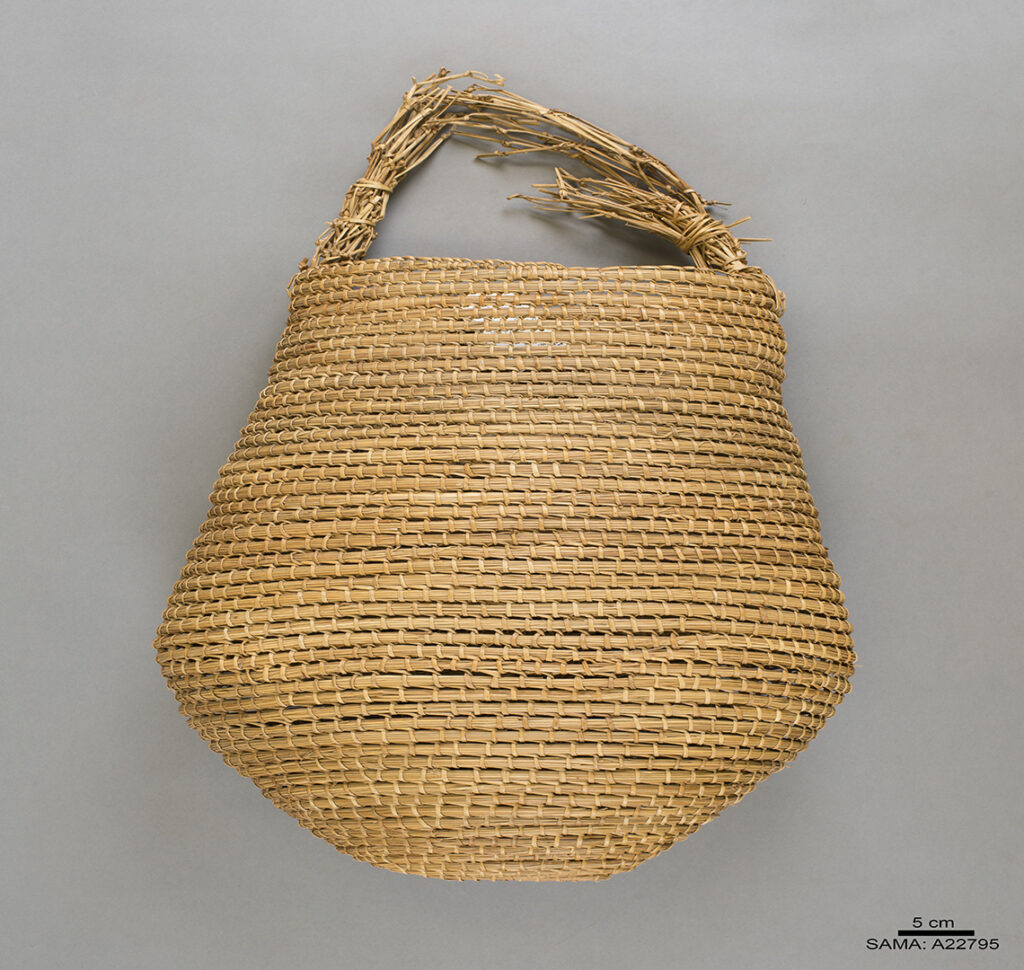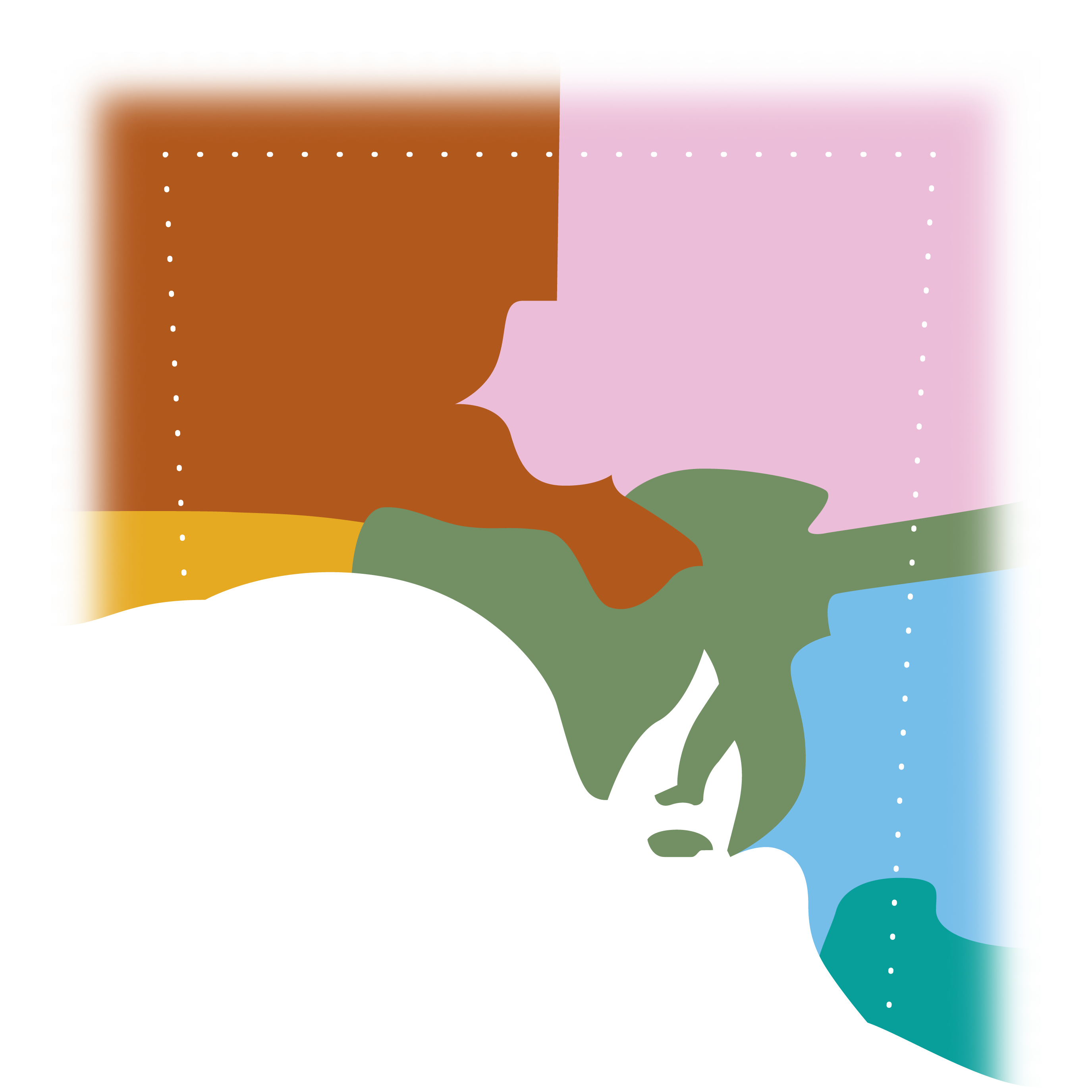
In this lesson you will learn some words related to weaving. Weaving is an important part of Tanganekald culture and so there are many words for baskets, mats, fish-traps, grasses and knots.
To learn more about woven fish traps, visit Lesson 10 – Fishing
Baskets, Fish-traps and Mats
Tanganekald people past and present practise weaving. There are many different words for baskets, mats and fish-traps which are woven into intricate patterns.
| karatparaki | basket (general term) | |
| karakoranyi | a type of basket | |
| karuaraki | a type of basket | |
| koiya | a type of basket | |
| kuranyi | a type of basket | |
| lakun | weaving (a basket, mat, etc.) | |
| marpi | a type of basket | |
| mulapani | a blanket made of waterweeds | |
| ngeiri | a fishing net made with basket reeds | |
| rakoranyi | a long basket for fish | |
| tulangampiri | round grass mat | |
| tulangapurri | a basket made of mallee bark and grass | |
| walakwalayi | a type of basket | |
| yelani | a long rectangular grass mat |
Here are some more details about some of the types of baskets and how they are used.
| karuaraki | a type of basket |
The karuaraki has a hair string net bundle which is decorated with feathers of a man's ngaitji 'totem'. A warrior would wear the karuaraki on their back as a challenge to opponents, who would try to hit the basket.
| kuranyi | a type of basket |
The kuranyi is coiled and had a hair-string handle so that it could be worn across the shoulders. The kuranyi has red, decorated walls, which got its colour from strands of a particular species of red reed. The kuranyi was worn across the shoulders during fighting as a challenge, 'if you can't hit the basket you can't hit me'. Kuranyi left on the field after a battle identified the men who ran away. The kuranyi is also used in collection of fruits such as the mantri 'muntry; emu apple'.
| koiya | a type of basket |
The koiya is twice as long as the kuranyi and has a netted cord for carrying over the shoulder.
| karakoranyi | a type of basket |
The karakoranyi, an elongated, coiled type of basket, is carried under the left arm and contained throwing clubs. The karakoranyi could also be used as a shield by its wearer.


First image: a karakoranyi basket made by Milerum in 1935. Second image: Close-up of the weave of a karakoranyi basket. South Australian Museum collection A22795.
Materials and tools used for weaving
Tanganekald people have always used a wide variety of materials in their weaving. This includes grasses, reeds, waterweeds, bark, and bone pins.
| karelanggi | a species of waterweed, found growing on stones | |
| keinyari | grasstree | |
| kuka | native flax | |
| ngamurrunyi | a species of waterweed, which was woven to make blankets | |
| ngapurri | grass | |
| pilbali | a soft rush | |
| pinkurubuk | a type of material used to make baskets | |
| tulangi | mallee bark | |
| wunapi | a sharp stick or bone, used to pin shut a soft basket when carrying it on the head |
Here is some more information about some of these materials and how they were used.
| karelanggi | a species of waterweed |
The karelanggi grows on stones. It is dries and rubbed with fat to make a type of string.
| kuka | native flax |
Kuka 'native flax' a grass like plant with blue flowers. It is used to make fishing lines and nets. An important place for locating kuka is at Kukaray 'Flax Point' .
| pilbali | a species of soft rush |
Pilbali is a soft rush used for making baskets and nets. Cattle eat this plant, so it is now very hard to find.
Knots and weaving techniques
Knots and weaving techniques have names in Tanganekald language which don't necessarily have equivalents in English. Let's learn some terms for knots and weaving.
| mulbakan | netting knot, the ties | |
| murraramun | to keep rushes under cover from sun (to prevent them growing stiff, for making into soft baskets) | |
| paremein | a single tie, a netting loop | |
| parenggaramein | a lashing made by winding around, used in net making |
Deadly work! Let’s have a look at some sentences using the vocabulary we’ve learned.
| Yaraberi karakoranyi-angk warra. | Carry the throwing club in the basket. |
yaraberi means 'throwing club', karakoranyi is a type of basket used for carrying clubs, the ending -angk means 'in', and warra means 'carry (it)'.
| Ngoponowi-il pilbali-ungai karatparaki lakun. | Uncle weaves a basket with soft rushes. |
ngoponowi means 'uncle; father's brother', the ending -il shows that the uncle is weaving, pilbali means 'a species of soft rush' , the ending -ungai means 'with' , karatparaki means 'basket (general term)' and lakun means 'weave'.
| Ngamurrunyi morok, mulapani lakurambi. | Gather the waterweed, in order to weave a blanket. |
ngamurrunyi means 'a species of waterweed', morok means 'gather (it)' (morokun means 'gather'), mulapani means 'a blanket made with waterweed', lakurambi means 'in order to weave' (lakun means 'weave').
| Pakanu-il pilbali murraramun. | Grandmother is keeping the rushes under cover. |
pakanu means 'grandmother; mother's mother', the ending -il shows that grandmother is doing the action of the sentence, pilbali means 'a species of so rush' and murraramun means 'keeping the rushes under cover from the sun'.

